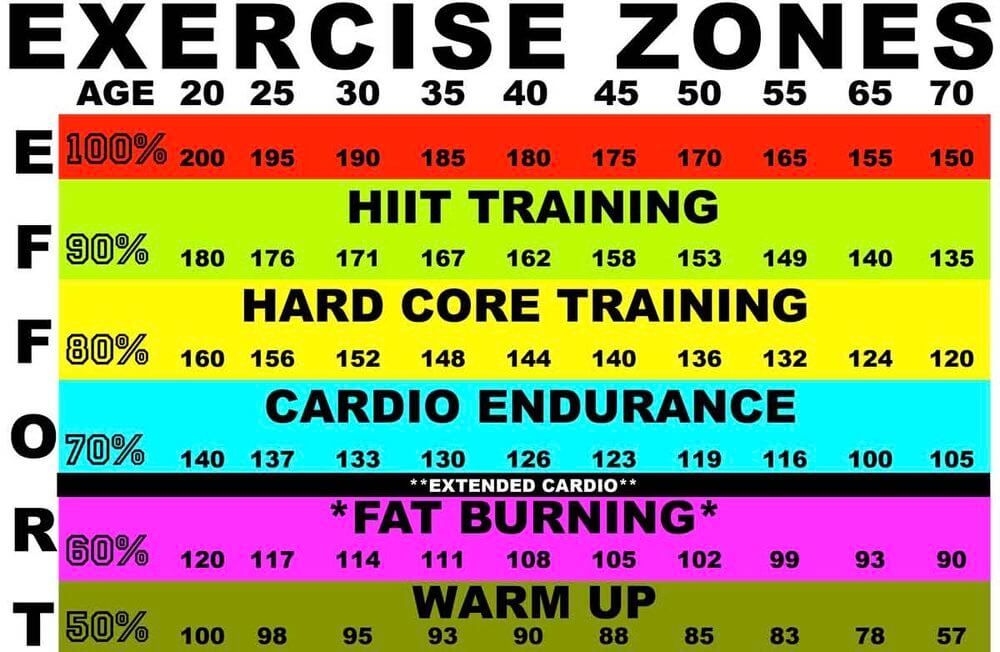Understanding Target Heart Rate for Weight Loss

Exercise heart rate zones are the training levels based on your maximum heart rate and are measured in (bpm) beats per minute. Your target heart rate is expressed as a percentage (usually between 60 percent and 70 percent) of your maximum safe heart rate. The target heart rate formula is used to find the number of beats per minute your workout has to be in to put your body in your heart rate zone.
Target heart rate formula: Target heart rate = (220 – Age) x exercise intensity
To be in your target heart rate zone for weight loss your exercise intensity has to be between 60% and 70% of your intensity. So, a 30 year old person training at 70% intensity will have a heart rate of (220 – 30) x .70 or 133 beats per minute (bpm). The sixty five percent intensity is within the range that is optimal for allowing your body to break down fat and use it as a source of energy.
Exercise intensity for the target heart rate formula explained
To understand the target heart rate formula for weight loss you need to understand what happens in other heart rate zones
- 50% – 60%: You’re exercising at 50% to 60% of your max heart rate. This could be walking, or light exercise that allows you to maintain conversation. Here, your body is burning sugars in the blood as energy. You’re generally able to sustain this zone the longest amount of time.
- 50-75%: You’re exercising at 60% to 75% of your max heart rate. This is your target heart rate zone for weight loss. Here your body breaks down fat to use as energy.
- 75%+: Working at over 75% of your max heart rate puts you in the aerobic zone. While performing vigorous activity, about 45% of the calories you burn are fat. But you’re burning a higher number of overall calories compared to the other heart rate zones. You generally sustain this zone the shortest amount of time.
Why do you burn less fat the harder you work out? “Once your heart rate increases, you’re not taking in as much oxygen. You can’t oxidize fat fast enough. Your body turns to another, more readily available energy source to provide fuel for you — glycogen, also known as carbohydrates.”
Burn Sugars | Burn Fat | Burn Carbs |
|---|---|---|
Intensity: 0-60% | Intensity: 60%-75% THR* | Intensity: 75%+ |
Heart Rate Zone Chart by Age
This table show heart rate zones for different ages.
Maximum heart rate = 220 – your age
Age | 50% – 85% Zone | Average Max Heart Rate, 100% |
|---|---|---|
20 years | 100-170 beats per minute (bpm) | 200 bpm |
30 years | 95-162 bpm | 190 bpm |
35 years | 93-157 bpm | 185 bpm |
40 years | 90-153 bpm | 180 bpm |
45 years | 88-149 bpm | 175 bpm |
50 years | 85-145 bpm | 170 bpm |
55 years | 83-140 bpm | 165 bpm |
60 years | 80-136 bpm | 160 bpm |
65 years | 78-132 bpm | 155 bpm |
70 years | 75-128 bpm | 150 bpm |
How do I find my pulse or heart rate?
Now that you have the target heart rate formula, you can monitor your heart rate to make sure you’re in your target hear rate zone. As you exercise, periodically check your heart rate. A wearable activity tracker makes it super easy, but if you don’t use one you can also find it manually:
- Take your pulse on the inside of your wrist, on the thumb side.
- Use the tips of your first two fingers (not your thumb) and press lightly over the artery.
- Count your pulse for 30 seconds and multiply by 2 to find your beats per minute.
How do I get in my target heart rate zone?
When you work out, are you doing too much or not enough? There’s a simple way to know: Your target heart rate helps you hit the bullseye so you can get max benefit from every step, swing and squat. Even if you’re not a gym rat or elite athlete, knowing your heart rate (or pulse) can help you track your health and fitness level.
What is a resting heart rate?
Your resting heart rate is the number of times your heart beats per minute when you’re at rest. A good time to check it is in the morning after you’ve had a good night’s sleep, before you get out of bed or grab that first cup of java!
Is resting heart rate different by age?
For most of us (adults), between 60 and 100 beats per minute (bpm) is normal. Your target heart rate and heart rate in general can be affected by factors like stress, anxiety, hormones, medication, and how physically active you are. An athlete or more active person may have a resting heart rate as low as 40 beats per minute. Now that’s chill!
When it comes to resting heart rate, lower is better. It usually means your heart muscle is in better condition and doesn’t have to work as hard to maintain a steady beat. Studies have found that a higher resting heart rate is linked with lower physical fitness and higher blood pressure and body weight.
Important Note: Some drugs and medications affect heart rate, meaning you may have a lower maximum heart rate and target zone. If you have a heart condition or take medication, ask your healthcare provider what your heart rate should be.
As you exercise, your heart rate will also differ based on age. See the graph below for how your heart rate changes based on age and exercise intensity:

How age and intensity affect heart rate.
What if my heart rate is too high or too low?
If your heart rate is too high, you’re straining. Slow your roll! If your heart rate is too low, and the intensity feels “light” to “moderate,” you may want to push yourself to exercise a little harder, especially if you’re trying to lose weight.
If you’re just starting out, aim for the lower range of intensity (50 percent) and gradually build up. The ideal target heart rate for weight loss is achieved when you exercise 60% to 75% of your max heart rate. A treadmill at the gym will display the number of calories burnt while you exercise. Keeping in mind that 3500 calories are the equivalent of 1lb of bodyweight you can do a calorie calculation for weight loss to learn how much you have to exercise and at what intensity to lose weight.
References:
1. All About Heart Rate (Pulse), American Heart Association website
2. Elevated resting heart rate, physical fitness and all-cause mortality, Epidemiology, 2013
3. Target Heart Rate and Estimated Maximum Heart Rate, Centers for Disease Control website